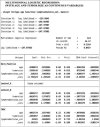Role of Immunophenotypes in Carcinoma Breast
- PMID: 30598906
- PMCID: PMC6259294
- DOI: 10.4103/ijabmr.IJABMR_331_17
Role of Immunophenotypes in Carcinoma Breast
Abstract
Background: Nottingham's modification of Bloom-Richardson histopathological grading system (NGS) for carcinoma breast is a time-tested prognostic indicator; however, of lately, breast cancer has been evaluated through molecular techniques, particularly assessing the gene expression profiling and establishing molecular or immunophenotypes. The present-day utility of NGS needs to be reassessed with the modern predictive markers, this may help refine breast cancer classification specifically to help improve the treatment protocol.
Objective: The objective was to compare breast cancer immunophenotypes with prognostic factors such as age (based on menstrual status), tumor size, lymph node (LN) status, also to compare the NGS grade with the molecular immunphenotypes of breast cancer.
Materials and methods: The present work was carried out in the Histopathology and Immunohistochemistry section of Department of Pathology, of a central Indian medical college and rural hospital from January 2013 to July 2016. It was a prospective analytical study. A tota1 of 114 female patients presenting in the outpatient department of surgery with lump in breast were included in the present study. All patients underwent modified radical mastectomy for tumor resection. Tumor masses and LNs were subjected to routine hematoxylin and eosin staining as well as immunohistochemistry then examined by a senior pathologist. Comparisons were made between molecular immunophenotypes with patient age, tumor size, and LN status, further NGS grade of breast cancer was compared with immunophenotypes.
Results: The study found that the molecular immunophenotypes when compared with clinical prognostic parameters, i.e; age (based on menstrual status of female), LN involvement in patients of breast carcinoma showed inconsequential correlation, the tumor size showed significant correlation. However, when histopathological grades were compared with molecular immunophenotypes, a significant correlation was seen.
Conclusion: NGS grade being an excellent predictive prognostic tool should be continued for assessing the grades in breast cancer patients. The molecular markers correlate with the histopathological grading and indirectly aid the oncologist in assessing the aggressiveness, these immunophenotypes are not helpful as suitable prognostic tools. As the molecular phenotypes definitely indicate the hormonal receptor status in breast cancer patients, they become mandatory in guiding oncologists for planning the treatment strategy and protocol.
Keywords: Carcinoma; Nottingham's Modification of Bloom Richardson's Grading system; histopathology; immunohistochemistry; immunophenotypes; lymph node; tumor node metastasis.
Conflict of interest statement
There are no conflicts of interest.
Figures



Similar articles
-
Robinson's cytological grading on aspirates of breast carcinoma: Correlation with Bloom Richardson's histological grading.J Cytol. 2009 Oct;26(4):140-3. doi: 10.4103/0970-9371.62182. J Cytol. 2009. PMID: 21938177 Free PMC article.
-
Prevalence of known prognostic factors in female breast carcinoma including oestrogen receptor, progesterone receptor and Her-2/neu status--a study in a tertiary care centre.J Indian Med Assoc. 2012 Dec;110(12):876-9. J Indian Med Assoc. 2012. PMID: 23936949
-
Comparative predictive value of three prognostic markers--S-phase fraction, PCNA and Mitotic count on axillary lymph node metastasis in carcinoma breast.J Ayub Med Coll Abbottabad. 2007 Jan-Mar;19(1):3-5. J Ayub Med Coll Abbottabad. 2007. PMID: 17867469
-
Correlation of proliferative index with various clinicopathologic prognostic parameters in primary breast carcinoma: A study from North India.J Cancer Res Ther. 2018 Apr-Jun;14(3):537-542. doi: 10.4103/0973-1482.167614. J Cancer Res Ther. 2018. PMID: 29893312
-
Molecular patterns of cancer colonisation in lymph nodes of breast cancer patients.Breast Cancer Res. 2018 Nov 20;20(1):143. doi: 10.1186/s13058-018-1070-3. Breast Cancer Res. 2018. PMID: 30458865 Free PMC article. Review.
Cited by
-
Association of Proliferative Indices With Various Grades of Breast Carcinoma.Cureus. 2023 Jul 14;15(7):e41865. doi: 10.7759/cureus.41865. eCollection 2023 Jul. Cureus. 2023. PMID: 37583729 Free PMC article.
References
-
- World Cancer Report. International Agency for Research on Cancer. 2008. [Last accessed on 2011 Jan 14; Last retrieved on 2011 Feb 26]. Available from: https://onlinelibrary.wiley.com/doi/abs/10.1002/ijc.25516 .
-
- World Health Organization. Breast Cancer: Prevention and Control. [Last accessed on 2015 Sep 06]. Available from: http://www.who.int/topics/cancer/breastcancer/en/
-
- American College of Obstetricians and Gynecologists. ACOG practice bulletin. Clinical management guidelines for obstetrician-gynecologists. Number 37, August 2002. (Replaces practice bulletin number 32, November 2001). Thyroid disease in pregnancy. Obstet Gynecol. 2002;100:387–96. - PubMed
-
- NCCN Clinical Practice Guidelines in Oncology: Breast Cancer. National Comprehensive Cancer Network. 2016. [Last accessed on 2015 Dec 30]. Available from: http://www.nccn.org/professionals/physician_gls/pdf/breast.pdf .
-
- Elston CW, Ellis IO. Pathological prognostic factors in breast cancer. I. The value of histological grade in breast cancer: Experience from a large study with long-term follow-up. Histopathology. 1991;19:403–10. - PubMed
LinkOut - more resources
Full Text Sources
Research Materials

